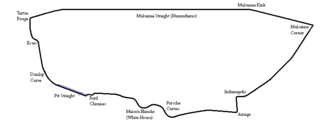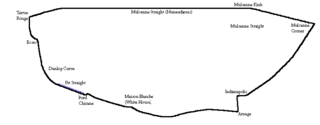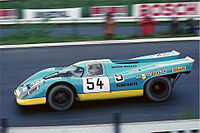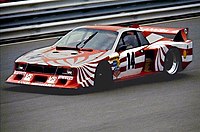
Sports car racing is a form of motorsport road racing which utilises sports cars that have two seats and enclosed wheels. They may be purpose-built prototypes or grand tourers based on road-going models. Sports car racing is one of the main types of circuit auto racing, alongside open-wheel racing, touring car racing and stock car racing. Sports car races are often, though not always, endurance races that are run over particularly long distances or large amounts of time, resulting in a larger emphasis on the reliability and efficiency of the car and its drivers as opposed to outright car performance or driver skills. The FIA World Endurance Championship is an example of one of the best known sports car racing series.

The Porsche 935 was a race car developed and manufactured by German automaker Porsche. Introduced in 1976 as the factory racing version of the 911 (930) Turbo and prepared for FIA-Group 5 rules, it was an evolution of the Carrera RSR 2.1 turbo prototype, the second place overall finisher in the 1974 24 Hours of Le Mans.

The Porsche 917 is a sports prototype race car developed by German manufacturer Porsche to exploit the regulations regarding the construction of 5-litre sports cars. Powered by a Type 912 flat-12 engine which was progressively enlarged from 4.5 to 5.0 litres, the 917 was introduced in 1969 and initially proved unwieldy on the race track but continuous development improved the handling and it went on to dominate sports-car racing in 1970 and 1971. In 1970 it gave Porsche its first overall win at the 24 Hours of Le Mans, a feat it would repeat in 1971. It would be chiefly responsible for Porsche winning the International Championship for Makes in 1970 and 1971. Porsche went on to develop the 917 for Can-Am racing, culminating in the twin-turbocharged 917/30 which was even more dominant in the role. Porsche drivers would win the Can-Am championship in 1972 and 1973. 917 drivers also won the Interserie championship every year from 1969 to 1975.

Group B was a set of regulations for grand touring (GT) vehicles used in sports car racing and rallying introduced in 1982 by the Fédération Internationale de l'Automobile (FIA). Although permitted to enter a GT class of the World Sportscar Championship alongside the more popular racing prototypes of Group C, Group B are commonly associated with the international rallying scene during 1982 to 1986 in popular culture, when they were the highest class used across rallying, including the World Rally Championship, regional and national championships.

Zakspeed is a motor racing team from Germany, founded in 1968 by Erich Zakowski and after that run by his son Peter Zakowski. It is based in Niederzissen, Rhineland-Palatinate, around 25 kilometres (16 mi) from the Nürburgring circuit.

John Wyer, was an English automobile racing engineer and team manager. He is mainly associated with cars running in the light blue and orange livery of his longtime sponsor Gulf Oil.

Ferrari 512 S is the designation for 25 sports cars built in 1969–70, with five-litre 12-cylinder ("512") engines, related to the Ferrari P sports prototypes. The V12-powered cars were entered in the 1970 International Championship for Makes by the factory Scuderia Ferrari and private teams. Later that year, modified versions resembling their main competitor, the Porsche 917, were called Ferrari 512 M. In the 1971 International Championship for Makes, the factory focused on the new Ferrari 312 PB and abandoned the 512 which was only entered by privateers. From 1972 onwards, the 512 was withdrawn from the world championship following a change in the regulations, and some 512s in private hands were entered in CanAm and Interserie races.

Group C was a category of sports car racing introduced by the FIA in 1982 and continuing until 1993, with Group A for touring cars and Group B for GTs.

The World Sportscar Championship was the world series run for sports car racing by the FIA from 1953 to 1992.

The Porsche 908 was a racing car from Porsche, introduced in 1968 to continue the Porsche 906-Porsche 910-Porsche 907 series of models designed by Helmuth Bott (chassis) and Hans Mezger (engine) under the leadership of racing chief Ferdinand Piëch.

The Lola T70 is a sports prototype developed by British manufacturer Lola Cars in 1965. Lola built the aluminium monocoque chassis, which were typically powered by large American V8s.

The 1976 24 Hours of Le Mans was the 44th Grand Prix of Endurance, and took place on 12 and 13 June 1976. This year the FIA introduced its new Group 5 and Group 6 regulations and the race was now open to nine distinct classes, although it was still not part of the World Championship seasons. Porsche introduced its new models, the 936 in Group 6, the 935 in Group 5 and the 934 in Group 4. In response, BMW had its modified 3.0 CSL in Group 5. It was the year that turbos arrived in considerable numbers, with over a dozen turbocharged entries, led by the Renault Alpine A442. It saw the arrival of French prototype manufacturers Jean Rondeau and Gérard Welter in a new GTP class and a first-time invitation to American IMSA and NASCAR entries.

The 1970 24 Hours of Le Mans was the 38th Grand Prix of Endurance and took place on 13 and 14 June 1970. It was the 8th stage of the 1970 World Sportscar Championship season.

The 1980 World Sportscar Championship season was the 28th season of FIA World Sportscar Championship motor racing. It featured the 1980 World Championship for Makes which was contested as a series running under both Fédération Internationale de l'Automobile (FIA) and International Motor Sports Association (IMSA) regulations. It ran from 2 February 1980 to 28 September 1980, and comprised 11 races, including races run with Camel GT Championship.

The 1968 World Sportscar Championship season was the 16th season of FIA World Sportscar Championship racing and featured the 1968 International Championship for Makes and the 1968 International Cup for GT Cars. The former was contested by Group 6 Sports Prototypes, Group 4 Sports Cars and Group 3 Grand Touring Cars and the later by Group 3 Grand Touring Cars only. The two titles were decided over a ten race series which ran from 3 February 1968 to 29 September 1968, but one race was only worth half points, and only the five best results were counted.
The 1971 International Championship for Makes season was the 19th season of FIA World Sportscar Championship motor racing. It was open to Group 6 Sports Prototypes, Group 5 Sportscars, and Group 4 Special GT Cars and was contested over an eleven race series which ran from 10 January to 24 July 1971. Porsche won the championship, and the German manufacturer also won the International Cup for GT Cars.

The Group 4 racing class referred to regulations for cars in sportscar racing, GT racing and rallying, as regulated by the FIA. The Group 4 class was replaced by Group B for the 1983 season.

The Australian GT Championship is a CAMS-sanctioned national title for drivers of GT cars, held annually from 1960 to 1963, from 1982 to 1985 and from 2005. Each championship up to and including the 1963 title was contested over a single race and those after that year over a series of races. The categories which have contested the championship have not always been well defined and often have become a home for cars orphaned by category collapse or a sudden change in regulation.

The Lola T600 was a racing car introduced in 1981 by Lola Cars as a customer chassis. It was the first GT prototype race car to incorporate ground-effect tunnels for downforce. The revolutionary aerodynamic design of the T600 was widely imitated throughout the 1980s by International Motor Sports Association (IMSA) and Group C prototype cars. The Lola T600 ran initially in the U.S.-based IMSA GT series and later in European Group C races.

Grand Touring Experimental (GTX) is a former classification and set of regulations designated to grand touring cars and sports prototypes in sports car racing competing in the IMSA GT Championship, maintained by IMSA between 1977 and 1982. Some cars were based on FIA Group 5 rules; such as the Porsche 935, and some cars were based on FIA Group 6 regulations, such as the Lola T600. Like the original GTO class, the class rules specified turbocharging and supercharging was allowed on engines up to a size of 6.0 L (370 cu in); with engine design and number of cylinders being free and unrestricted. Engines over 6.0 L (370 cu in) were required to be naturally-aspirated.





















